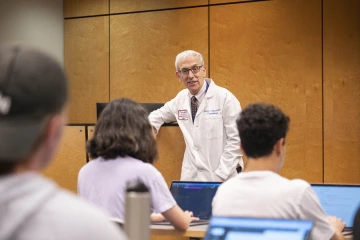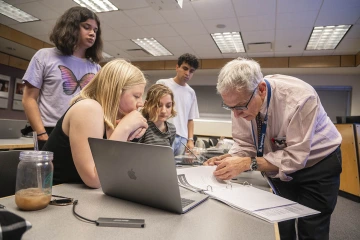Dr. Marvin Slepian follows where inspiration leads
Curiosity guides the Regents Professor to bridge medicine, engineering and now the law to address unmet needs in research and mentorship.

Regents Professor Marvin Slepian, MD, JD, is a renaissance man whose curiosity as a child has only continued to grow, leading him to hundreds of patents and a lifetime of mentorship.
Inducted into the National Academy of Inventors in 2019, Marvin Slepian, MD, JD, is a named inventor on over 160 issued or pending patents. A Regents Professor of Medicine and Medical Imaging in the University of Arizona College of Medicine – Tucson and Biomedical Engineering at the UArizona College of Engineering, Dr. Slepian co-founded SynCardia Systems, which makes the only FDA-approved total artificial heart, and has founded several other medical device companies. He’s brought revolutionary ideas to medicine, such as stents that release drugs and a “paving” material to repair and treat arteries and other tissues, and has taught innovation, literally, for the past decade.
The secret to his success? There isn’t one. That is, there isn’t just one.
Addressing unmet needs

Marvin Slepian, MD, JD, is a Regents Professor of Medicine and Medical Imaging in the University of Arizona College of Medicine - Tucson and Biomedical Engineering at the UArizona College of Engineering and recently earned his law degree.
In the early 1980s, fresh out of medical school and a young intern at Bellevue, the teaching hospital of New York University, Dr. Slepian witnessed first-hand the growing epidemic of heart disorders. The magnitude of the problem and the unmet need for care drove Dr. Slepian onto a path that shaped his life for decades to come.
“My whole background was in microbiology and biochemistry, which would lend itself to working on infectious disease or cancer medicine or rheumatology,” said Dr. Slepian, who is also a member of both the Sarver Heart Center and BIO5 Institute. “Cardiology is tubes, pipes and pressures – more engineering. But I saw this gap, so I said, ‘What, if I take everything I know on the molecular side and put it into cardiology?’”
That decision took his work and education down new paths, exploring platelet clotting, inflammation and cell regrowth – complications that within just a few years would limit the effectiveness of interventions like angioplasty and stents. They were complications that his pioneering work and commitment to unmet needs would ultimately help overcome.
Curiosity and exposure
“I was always a curious kid, looking at pond water under the microscope, building things at an early age, mixing chemicals and examining their effects on plants and cells,” Dr. Slepian recalls. But successful innovation takes more than just a curious mind, he says. It thrives on exposure.
Dr. Slepian’s parents encouraged his curiosity from the start. His mother was a high school principal, and his father taught medicine and had a lab in their home. He went to Stuyvesant High School, one of New York City’s “specialized” public college prep high schools with a heavy focus on science. He won science fairs and as a freshman in college was selected to be the U.S. student representative for that year’s Nobel Prize ceremonies.

Mentorship is a critical component of learning in Dr. Slepian’s world. As a young student, mentorship fueled his curiosity and as a leader, he provides it to those around him.
While a freshman in high school, Dr. Slepian began to experiment with viral systems and by his senior year had developed five methods for creating polymer-based synthetic viruses that were capable of packaging exogenous DNA by encapsulating it within protein structures.
Yes, Dr. Slepian developed a novel drug-delivery system that essentially hijacked the infection vectors of engineered, large-molecule viruses in high school.
Not surprisingly, he swept awards on the science fair circuit, even competing internationally. His work won awards from the Army, Navy, Air Force and Atomic Energy Commission. And he credits that success, in part, to his mentor, Abraham Baumel, a chemistry and physics teacher and City College professor who would go on to become Stuyvesant’s principal.
Dr. Slepian chose to attend Princeton University for its program in science and human affairs. As an undergrad, he became a radio announcer for WPRB, fascinated by the flow of information from the pre-internet teletype news feed. He worked with the Robert Wood Johnson Foundation, to study the impact of social work on health care and sought friends who were studying in the humanities.
“You can't just be a narrowly focused science or technical person,” he said. “You have to be sensitive to society, people and the world around you. Interdisciplinary work is the buzzword today, but it’s absolutely critical you take some humanities, you understand some math and computing, gain exposure to arts and letters and civics. It’s all important.”
Critical mentorship
“Interdisciplinary work is the buzzword today, but it’s absolutely critical you take some humanities, you understand some math and computing, gain exposure to arts and letters and civics.”
Marvin Slepian, MD, JD
Mentorship would play a key role in Dr. Slepian’s education and professional development, and he returns the favor now by mentoring more than 100 undergraduate and graduate students a year – some through his Innovation, Translation & Entrepreneurship course, some through students taking electives and some through an initiative he created for team-based engineering and design.
“I’m very passionate about students getting their hands wet and doing things you can actually see,” Dr. Slepian says. “I’ve always had great teachers who gave me great insights. It’s all about mentorship. You need to excite, inspire, guide and propel others. That’s something I might want on my tombstone.”
Multiple perspectives
His lab work continued throughout medical school, and a five-month stint at the National Institutes of Health gave him a much broader understanding of health and medicine, including basic knowledge of cancer, arthritis, metabolism, allergy and infectious diseases. His focus on immunology while there led him to explore connections between inflammation, the immune system and platelet function.
It was the layering of all those experiences that led him to invent endoluminal paving as an alternative to the contemporary technology of stents made of steel. Dr. Slepian patented a biodegradable polymer material that lines the inner walls of arteries, simultaneously providing structural support, a therapeutic barrier and a pathway for drug delivery.
“I took this work from 15 years prior and reapplied it in a cardiovascular domain,” he says. “I tell this to students: You have to understand different things. You absolutely have to be really good at a few things, but you also need familiarity with multiple fields to be able to then pull from them and integrate. That’s key.”
Incremental learning
On a sunny Saturday in May, Marvin Slepian graduated from the UArizona James E. Rogers College of Law, adding “JD” to the “MD” that has followed his name since 1981.
He’d been interested in law at an early age and repeatedly found himself unpacking legal issues as a physician-scientist inventor and entrepreneur. For him, law school was a natural extension of lifelong learning: residency at NYU School of Medicine, research and clinical fellowships at Johns Hopkins University and the Cleveland Clinic, post-doctoral training in polymer chemistry and chemical engineering at Massachusetts Institute of Technology and business and management training at Harvard Business School.
“As you evolve, as your career progresses, you’re going to need more information. But the point is, there’s never an easy way to get it all at once. Most people can’t just stop their careers and go back to school. But you add something here and you add something there, and over time, it all adds up.”
“You're never going to be an expert in everything,” Dr. Slepian says, “but you need to get in the water and swim around.”

